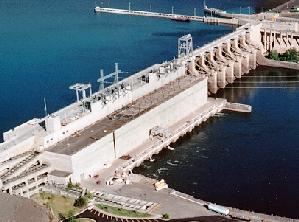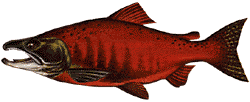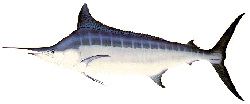 |
 |
 |
 |
 |
 |
 |
 |
 |
 |
 |
 |
 |
 |
 |
 |
 |
 |
 |
 |
 |
 |
 |
 |
 |
 |
 |
|
 |
|
|
 |
|
|
|
 |
|
|
|
|
DAMS and DIVERSIONS of FRESHWATER FLOWS |
|
|
|
Alteration of flows by means of dams or diversions can be the single most important factor influencing the health of many riverine and estuarine ecosystems and can eliminate populations of species dependent upon rivers for reproduction.� Columbia and Snake River Basin salmon and steelhead, which now number about one half million wild fish, have declined by 95-97% from estimated historic levels of 10-16 million spawners (from NPPC 1986).� Two thirds of the Columbia and Snake River Basin, which was accessible to salmon and steelhead, has been blocked by the construction of 55 major dams and a large number of smaller dams.� The American Fisheries Society estimates that as many as half of the original Pacific salmon races have been lost;� and of those 214 remaining, 101 are at high risk of extinction, 58 are at moderate risk, and 54 are of special concern (Nehlsen et al. 1991).� Snake River sockeye salmon and two Snake River chinook salmon (the spring/summer run and the fall run) are now listed as an "endangered" species under the Federal Endangered Species Act (ESA).� Federal fishery managers (NMFS) initially responded by limiting fishing, which is responsible for mortality estimated to be 0.3% for spring/summer chinook, 7.3% for fall chinook, and 1% for sockeye salmon, but ignoring the primary cuases of mortality at the dams estimated to be 99.8%, 92.7%, and 99%, respectively (Hallock 1993).� Protective measures required by listing are already having major effects on the region's economy and way of life.� Between 1978 and 1991, annual commercial landings of inshore-dependent fish and shellfish by the states of Washington and Oregon declined 15% by weight (12,500 mt) and 52% in value (or $118 million annually in constant dollars). |
|
|
|
Flow diversions can be equally devastating.� For example, more than 90% of California's salmon spawning habitat has been lost due to extensive Federal and state water projects throughout the Central Valley.� Most California races of salmon, steelhead, striped bass, and other migratory species have declined dramatically (Moyle and Morford 1991).� In only the past 20 years, Sacramento River winter run chinook salmon have declined 99.9%, from 86,500 in 1967-69 to only 191 in 1991 (F.Fisher, personal communication: 1991), and they are now listed as endangered under the ESA.� Spawning has been eliminated on the San Joaquin River system, which drains the southern half of the Central Valley, and drastically reduced on the Sacramento River system, which drains its northern half (Kier 1992).� Striped bass of San Francisco Bay-Delta declined 62% between 1972 and 1991, from landings of 1.8 million to 682,000.� The survival of both striped bass and salmon has been shown to be directly related to the amounts and timing of freshwater flows experienced by the young (Rozengurt et al. 1987a, Rozengurt 1992), and by the number of downstream migrants pumped out of the river with irrigation waters (used to grow livestock hay in adjacent former wetland areas).� Thousands of unscreened intakes in the Delta, the primary nursery area located above San Francisco Bay, also kill millions of young salmon and striped bass, annually (Rozengurt and Haydock 1993). |
|
|
|
Moyle and Yoshiyama (1992) summarize California's state-wide situation (under the state's ESA) as follows.� Of 116 native fishes, 7% are extinct, 37% are threatened or endangered, and 19% may soon qualify as threatened.� Coho salmon, which once numbered 200,000 spawners, have declined to less than 5,000, and are extirpated from 46% of the 582 streams where once they were found.� Pink salmon are now extinct in the state.� Chinook salmon populations, the mainstay of California's salmon fishery, are in a state of collapse.� The winter run is already listed as endangered, and the spring runs of both the Klamath and Sacramento Rivers are down to less than 1,000 fish each, and qualify for endangered status.� The fall run, which is the principal run still fished, is declining rapidly throughout California.� Steelhead, the legendary sport fish, is in decline throughout its range.� Summer steelhead qualify for threatened species status as do the southern populations of winter steelhead.� Coastal cutthroat numbers are diminished enough to be a species of special concern.� Green sturgeon no longer spawn in a number of their former streams and now only in the Sacramento, Klamath, and Rogue River (OR).� These populations are in danger of collapse. |
|
|
|
From 1978 to 1991, California's commercial landings of inshore-dependent fish and shellfish declined 32% by weight (by 17,700 mt) and 30% by value, or $20 million annually (in constant dollars).� According to the Pacific Fishery Management Council, more than 40,000 fishing and processing jobs have been lost in California since 1978.� Over the past decade, fishermen have faced substantial reductions in their fishing.� During this period, West Coast forests were logged extensively, watersheds that support salmon and other inshore-dependent species were destroyed, and massive water diversions have continued.� Increased restrictions on the fishing community have not changed the dynamics, and actually penalize those who are not primarily responsible for anadromous populations' declines.� Pacific coast salmon, like California's commercial fishermen, are in danger of disappearing, due primarily to watershed habitat degradation and loss caused by logging (Moyle and Yoshiyama 1992) and heavily subsidized irrigation for agriculture that, according to former Senator Bill Bradley (1993), contributes only 2% to the state's economy but uses 85% of the state's water. |
|
|
|
Reducing flows to estuaries (particularly during the spring when flows are greatest) also decreases their productivity.� A national symposium on the effects of freshwater diversions concluded that "based on worldwide experience, no more than 25-30% (Rozengurt and Haydock 1981) of the historical river flow to an estuary can be diverted without disastrous ecological consequences to the receiving estuary" (Clark and Benson, 1981).� Many U.S. estuaries have been affected, most notably the "Everglades" and Florida Bay which have lost more than 95% of historic flows.� Some of Texas's estuaries have lost up to 90% of their historic inflows due to upstream diversions.� An estimated 50% of the annual historic freshwater inflows to San Francisco Bay are now diverted (Rozengurt and Herz 1981), but will increase to 75% if planned Federal and state water projects (e.g., the Peripheral Canal) are constructed (Rozengurt et al. 1987b, Rozengurt et al. 1985).� Springtime flows, a critical period for downstream-migrating juvenile salmon, have been reduced in the Columbia River to 50% of historic levels (Simenstad et al. 1992).� Chesapeake Bay's spring inflows have now been reduced by as much as 40% in low flow years (Robinson 1981). |
|
|
|
THE SOVIET UNION EXPERIENCE |
|
|
|
Perhaps the clearest example, of the significance of the ecological and economic effects of large scale diversion of freshwater inflows, comes from the southern portion of the former Soviet Union (Rozengurt and Herz 1981, Rozengurt et al. 1985, Rozengurt and Haydock 1991).� The U.S.S.R. built 30 major dams on rivers flowing into the great estuaries of its south - the Black, Caspian, Azov, and Aral Seas (as depicted above).� These dams hold back between 30% and 97% of the flow of freshwater into these estuaries.� Most of the retained water is used to irrigate cotton and rice in semi-arid and arid areas.� The dams have destroyed fish migration routes, spawning and nursery grounds, and eliminated 90-98% of the valuable species of commercial fish in all the major rivers and estuaries of the southern U.S.S.R. (Rozengurt et al. 1987a).� All attempts to restore the fisheries have failed (Rozengurt 1991).� Within just twenty years, the Aral Sea changed from one of the most productive seas in the world to a virtual desert.� With its river inflows diverted, this sea dried up, salt dust was blown from the sea bottom and fell back to earth destroying crops for hundreds of miles downwind.� Economic losses amounted to about $6.5 billion annually.� Toxins accumulated in soils and contaminated drinking wells, making the region unfit for human habitation.� Infant mortality in central Asia (Aral Sea watershed) is nearly 5 times the Soviet average - a staggering 10-18% of all babies born.� For these and other reasons, the Soviet Union has come to symbolize the epitome of blindness to ecosystem sustainability in a misguided search for short-term economic gains and disastrous environmental mistakes that can only be rectified by an overhaul of the entire system (of the western Black, Azov, Caspian Seas;� the Aral Sea is lost) at costs in the hundreds of billions of dollars.� Unfortunately, the United States appears to be following the Soviet Union's approach throughout the "Sunbelt."� San Francisco Bay "shows signs of deterioration whose scale is only slightly less ominous than that in the northwestern Black and Azov Seas" (Rozengurt 1992). |
|
|
|
 |
|
|
|
GO TO:
Habitat
Habitat Protection Division
Importance of Shallow Water Habitat to Fish
Primary Causes of Marine Fishery Declines
Wetlands
Toxics
Nutrients
Cumulative Effects
Economic Values at Risk
References
Swordfish, Billfish, Tunas and Sharks
Headed for Extinction
Swordfish
Marlin
Sailfish
Bluefin Tuna
Sharks
Chambers' Articles about Big Game Fish
Index
Photos of Big Game Fish
Index
Chambers and Associates
Overview
Description of the Firm
List of All Pages on this Website
Home |
|
|
 |
|
|
|
|
|
Chambers and Associates
9814 Kensington Parkway
Kensington, Maryland 20895
(301) 949-3003
Email�� [email protected]
Website�� www.Chambers-Associates.org |
|
|
|
|




